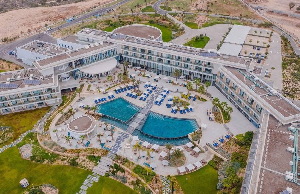The Maroua Salak airport will begin receiving international flights by the end of 2015. The revelation was made recently by the Director General of the Cameroon Civil Aviation Authority, Pierre Tankam, after visiting equipment installed at the airport to make it up to international norms.
A presidential decree of April 16 2014, transformed the Maroua Salak airport into an international airport. Since then, the airport has been undergoing transformation through installation of equipment to give it an international standard.
Amongst the equipment being installed at the Maroua Salak airport include: an air navigation safety equipment which guides airplanes to land and take off safely, as well as automatic weather observation equipment which gives pilots information on visibility conditions.
According to the Director General, of the Cameroon Civil Aviation Authority, the installation of the equipment will be completed by the end of June 2015. Installed at the airport, are two generators of 250KVA each to solve the problem of power cuts, while two new fire fighting vehicles are already in service.
At a press conference granted at the end of the visit of installed equipment, Pierre Tankam gave assurance that the equipment is state-of- the- art equipment and the airport will have nothing to envy from other international airports in the country.
He said that what is left to be done is to extend the run way from 2100m to 2800m so as to make it possible for heavy carriers to land in the airport, provide security and goods travelling conditions for passengers.
The Director General was hopeful that all of these will be done, and the Maroua Salak airport will begin receiving air flights by the end of 2015;
Speaking to the press, the DG said he is leaving Maroua Salak satisfied with what he has seen. “The equipment that were necessary to improve on the safety of air navigation in Maroua Salak are gradually being implemented. We saw the fire fighting vehicles that are already operational at the airport.
We saw the automatic weather observation system, precision approach path indicator, the VHF Omnidirectional Range, the distance measuring equipment, an airlift control desk and others which are already installed. We saw the civil engineering work of the Instrument Landing System that has been completed. A lot has been done.”
He added that even though he is satisfied, he will keep on monitoring the remaining works to be carried out in the field to make sure that by the end of the month of July, everything will be finished and ensure that the safety of air navigation in Maroua Salak International Airport is at least at the same standard with that of the Yaounde and Douala international airports.
“I must assure you that Maroua has already been operating international flights but for the moment, the Minister has asked the Civil Aviation Authority to ensure that everything is put in place to permit Maroua Salak Airport to receive intercontinental flight.
So more investment, in the field of security and facilitations are still be put be done. We are going to ask for some funding from government so that those investments can be realized at very short notice to permit this airport to offer the population of this region, the standard it deserves.”
According to experts at the airport, most of the equipment that have been installed are not found in the other two international airports in the country. Since the destructive floods that occurred in 2012 in the Far North region, with instructions from the Head of State, an emergency relief programme was created, with the aim of providing lasting solutions to the problems of floods in the region.
The emergency program for the fight against floods in the far north region, known by its French acronym PULCI, was created last year September, and is benefitting financing of the sum of 54 billion FCFA from the World Bank.
Works within the framework of the program include the rehabilitation of the dyke of the banks of river Logone and lake Maga, securing and relocating the victim population to a permanent site that will be provided them and to step up the rice production in the area.
Actualités of Wednesday, 9 July 2014
Source: The Post Newspaper













